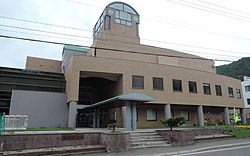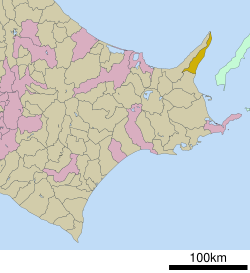
A | B | C | D | E | F | G | H | CH | I | J | K | L | M | N | O | P | Q | R | S | T | U | V | W | X | Y | Z | 0 | 1 | 2 | 3 | 4 | 5 | 6 | 7 | 8 | 9
This article needs additional citations for verification. (October 2022) |
You can help expand this article with text translated from the corresponding article in Japanese. (June 2022) Click for important translation instructions.
|
Rausu
羅臼町 | |
|---|---|
Town | |
 Rausu town hall | |
 Location of Rausu in Hokkaido (Nemuro Subprefecture) | |
| Coordinates: 44°1′N 145°11′E / 44.017°N 145.183°E | |
| Country | Japan |
| Region | Hokkaido |
| Prefecture | Hokkaido (Nemuro Subprefecture) |
| District | Menashi |
| Area | |
| • Total | 397.88 km2 (153.62 sq mi) |
| Population (September 30, 2016) | |
| • Total | 5,395 |
| • Density | 14/km2 (35/sq mi) |
| Time zone | UTC+09:00 (JST) |
| Climate | Dfb |
| Website | www |
Rausu (羅臼町, Rausu-chō) is a town located in Nemuro Subprefecture, Hokkaido, Japan. As of September 30, 2016, it has an estimated population of 5,395, and an area of 397.88 km2.
The word "Rausu" originates from the Ainu word Raushi, roughly meaning "Low-land" or "Place of men with beast-like spirit".
The town occupies the southern half of the Shiretoko Peninsula. Kunashir Island, one of the four disputed Kuril Islands, can be seen from the town.
Geographyedit
Rausu is located on the east end of Hokkaido's Shiretoko Peninsula. It is situated on the southeast corner of the peninsula facing the Nemuro Strait. The town stretches along and narrow strip of land, extending 64 km (40 mi) from southwest to northeast. The Shiretoko mountain range extends north on the peninsula to the sea where it forms steep cliffs. The Shiretoko mountain range is the source for myriad rivers, that all empty into the sea. Village communities are found mostly on the coast line at the mouths of these rivers. The "downtown" of Rausu is at the mouth of Rausu River where it joins the sea at Rausu Harbor.
Two access points to Rausu via highway are through Shibetsu in the south or through Shari on the west side of the Shiretoko Peninsula. From Shibetsu, National Highway 335 (the Kunashiri Highway) extends northwards along the coast into Rausu at which point it crosses the peninsula heading west, over the Shiretoko mountain range (the Shiretoko Pass). The Shiretoko Pass leads into Shari and becomes National Highway 334 (Shiretoko Crossing). Some sections of both highways (334 and 335) feature steep precipices just off the shoulder and may prove dangerous. There are also a number of tunnels along both highways. Rausu is about 70 km (43 mi) northeast from Nakashibetsu airport. It is 120 km (75 mi) northeast of Kushiro City.
- Mountains: Mount Rausu (1,660m/ 1.03 miles); Mount Shiretoko Sulphur Spring (1,563m/ 0.97miles)
- Major rivers: Rausu River
- Major lakes and marshes: Lake Rausu
Climateedit
| Climate data for Rausu (2005−2020 normals, extremes 2005−present) | |||||||||||||
|---|---|---|---|---|---|---|---|---|---|---|---|---|---|
| Month | Jan | Feb | Mar | Apr | May | Jun | Jul | Aug | Sep | Oct | Nov | Dec | Year |
| Record high °C (°F) | 7.0 (44.6) |
9.6 (49.3) |
13.9 (57.0) |
22.5 (72.5) |
29.4 (84.9) |
30.9 (87.6) |
30.7 (87.3) |
32.4 (90.3) |
29.8 (85.6) |
23.1 (73.6) |
19.2 (66.6) |
12.7 (54.9) |
32.4 (90.3) |
| Mean daily maximum °C (°F) | −1.8 (28.8) |
−1.8 (28.8) |
2.0 (35.6) |
6.9 (44.4) |
12.2 (54.0) |
15.2 (59.4) |
18.9 (66.0) |
21.3 (70.3) |
19.5 (67.1) |
14.1 (57.4) |
7.5 (45.5) |
1.4 (34.5) |
9.6 (49.3) |
| Daily mean °C (°F) | −4.5 (23.9) |
−4.8 (23.4) |
−1.1 (30.0) |
2.9 (37.2) |
7.8 (46.0) |
11.5 (52.7) |
15.4 (59.7) |
17.8 (64.0) |
15.7 (60.3) |
10.1 (50.2) |
4.1 (39.4) |
−1.4 (29.5) |
6.1 (43.0) |
| Mean daily minimum °C (°F) | −7.5 (18.5) |
−8.2 (17.2) |
−4.3 (24.3) |
−0.4 (31.3) |
4.2 (39.6) |
8.6 (47.5) |
12.7 (54.9) |
15.0 (59.0) |
12.2 (54.0) |
6.2 (43.2) |
0.7 (33.3) |
−4.4 (24.1) |
2.9 (37.2) |
| Record low °C (°F) | −15.7 (3.7) |
−17.3 (0.9) |
−11.7 (10.9) |
−10.1 (13.8) |
−1.5 (29.3) |
1.0 (33.8) |
5.7 (42.3) |
8.7 (47.7) |
5.4 (41.7) |
−1.9 (28.6) |
−8.9 (16.0) |
−13.4 (7.9) |
−17.3 (0.9) |
| Average precipitation mm (inches) | 89.7 (3.53) |
66.6 (2.62) |
93.9 (3.70) |
111.7 (4.40) |
144.0 (5.67) |
119.4 (4.70) |
125.4 (4.94) |
200.5 (7.89) |
204.7 (8.06) |
214.1 (8.43) |
150.7 (5.93) |
133.8 (5.27) |
1,657.1 (65.24) |
| Average snowfall cm (inches) | 149 (59) |
119 (47) |
95 (37) |
38 (15) |
2 (0.8) |
0 (0) |
0 (0) |
0 (0) |
0 (0) |
1 (0.4) |
30 (12) |
114 (45) |
545 (215) |
| Average precipitation days (≥ 1.0 mm) | 13.6 | 9.0 | 8.9 | 9.3 | 11.3 | 9.7 | 10.7 | 12.8 | 13.5 | 13.8 | 14.8 | 16.1 | 143.5 |
| Average snowy days (≥ 3 cm) | 16.1 | 11.8 | 11.1 | 5.1 | 0.3 | 0 | 0 | 0 | 0 | 0.1 | 3.6 | 13.2 | 61.3 |
| Mean monthly sunshine hours | 88.3 | 117.3 | 139.0 | 153.1 | 164.9 | 128.4 | 114.7 | 108.0 | 124.6 | 134.8 | 104.8 | 93.0 | 1,473.2 |
| Source: Japan Meteorological Agency[1][2] | |||||||||||||
Adjoining municipalitiesedit
Historyedit
- 1901 (Meiji 34) — Uebetsu Village split from Shibetsu.
- 1923 (Taishō 12) — Uebetsu becomes second-class municipality.
- 1930 (Shōwa 5) — Uebetsu is renamed Rausu Village.
- 1961 (Shōwa 36) — Rausu becomes the Rausu Town.
In 2004, there were talks held in Nakashibetsu amongst all the municipalities in the area to form one large township called East Shiretoko. Soon thereafter local residents were polled regarding the proposal. The faction in favor of this change did not receive support and thus abandoned the effort.
Local economyedit
Rausu's local economy consists of three main sources: the fishing industry, Shiretoko tourism, and local businesses.
Fishing industryedit
Rausu is primarily a fishing town. One third of residents are supported by the fishing industry. The main intake by the fishing industry consists of kichiji rockfish (Sebastolobus macrochir), Alaska Pollock (Theragra chalcogramma), konbu kelp, salmon, squid, and sea urchin. Particularly famous is Rausu konbu (Rausu kelp). There is no other place in Japan to harvest sea urchin from winter to summer other than Rausu. As for agriculture, in southern Rausu there is some dairy farming, but no land suitable for growing rice, produce, or other large scale agriculture. The lumber industry does not have much of a presence either (as it does in the rest of Hokkaido). 70% of the town's land is lush mountain forest, but it is mostly a part of the Shiretoko National Park.
Local businessedit
Rausu's second major source of economic income is not any one specific industry, but rather the mix of local retail, municipal employment, food and beverage industry, etc.
Shiretoko National Parkedit
The third major source of revenue for Rausu is related to Shiretoko National Park. The splendor of Shiretoko’s forests and the abundance of aquatic life in the Nemuro Strait form the basis of the local tourist industry. Due to the widening of Kunashiri Highway, in recent years whale and dolphin watching have become popular in the summer, whereas viewing Steller’s sea eagle, white-tailed (sea) eagles, (earless) seals, and drift-ice are popular in the winter. These activities are usually done by chartered cruises that cater to researchers, photographers, and bird watchers. Rausu is known for fresh rockfish, early-season salmon and salmon eggs, Alaskan pollock, squid, and sea urchin. The town has many bed-and-breakfasts, lodges, onsen hotels, restaurants, and bars. There is also a roadside station that sells local Shiretoko-area products.
Local business groupsedit
- Rausu Deep Ocean Fishing Association
- Rausu Fisherman’s Association
Financial institutionsedit
- Daichi Credit Union, Rausu branch
- Rausu Post Office
Municipal servicesedit
Japan Postedit
- Rausu Post Office (serves as a distribution point for Nakashibetsu Japan Postal Service Center hub)
- Misaki-chō annex of the Rausu Post Office
- Yagihama annex of the Rausu Post Office
- Minehama limited-service mail center
Police forceedit
- Rausu Police Department is a sub-station of Nakashibetsu Police Department
Japanese military/Coast Guard presenceedit
Due to the close proximity of Russia and potential fishing-rights disputes, the Japanese Coast Guard maintains a presence in Rausu year round. Coast Guard vessels are regularly docked in Rausu Harbor, with the personnel barracks nearby.
The Japanese Self-Defense Force maintains a permanent presence in the town.
Education systemedit
Like most high schools in Japan, the local senior high school falls under the administration of the prefectural board of education, while the local middle and elementary schools are operated by the local board of education.
Senior high schoolsedit
Middle/junior high schoolsedit
- Shunshō Middle School
- Rausu Middle School
- Chienbetsu Middle School (Closed Spring 2008 due to low population)
- Uebetsu Middle School (Closed Spring 2010 due to low population)
- Tobinitai Middle School (Closed Spring 2010 due to low population)
Elementary schoolsedit
- Shunshō Elementary School
- Rausu Elementary School
- Uebetsu Elementary School (Closed Spring 2010 due to low population)
- Tobinitai Middle School (Closed Spring 2010 due to low population)
The Rausu Board of Education has participated in the Ministry of Education, Culture, Sports, Science and Technology's (MEXT) Japan Exchange and Teaching (JET) Programme since summer 1993. The JET program helps place native English speakers in both prefectural and local boards of education to work as Assistant Language Teachers (ALT) with the goal of developing Japan's foreign language education.
Transportationedit
Airportsedit
- Nemuro-Nakashibetsu Airport (Nakashibetsu, Hokkaido)
Busesedit
Zdroj:https://en.wikipedia.org?pojem=Rausu,_HokkaidoText je dostupný za podmienok Creative Commons Attribution/Share-Alike License 3.0 Unported; prípadne za ďalších podmienok. Podrobnejšie informácie nájdete na stránke Podmienky použitia.
Antropológia
Aplikované vedy
Bibliometria
Dejiny vedy
Encyklopédie
Filozofia vedy
Forenzné vedy
Humanitné vedy
Knižničná veda
Kryogenika
Kryptológia
Kulturológia
Literárna veda
Medzidisciplinárne oblasti
Metódy kvantitatívnej analýzy
Metavedy
Metodika
Text je dostupný za podmienok Creative
Commons Attribution/Share-Alike License 3.0 Unported; prípadne za ďalších
podmienok.
Podrobnejšie informácie nájdete na stránke Podmienky
použitia.
www.astronomia.sk | www.biologia.sk | www.botanika.sk | www.dejiny.sk | www.economy.sk | www.elektrotechnika.sk | www.estetika.sk | www.farmakologia.sk | www.filozofia.sk | Fyzika | www.futurologia.sk | www.genetika.sk | www.chemia.sk | www.lingvistika.sk | www.politologia.sk | www.psychologia.sk | www.sexuologia.sk | www.sociologia.sk | www.veda.sk I www.zoologia.sk



